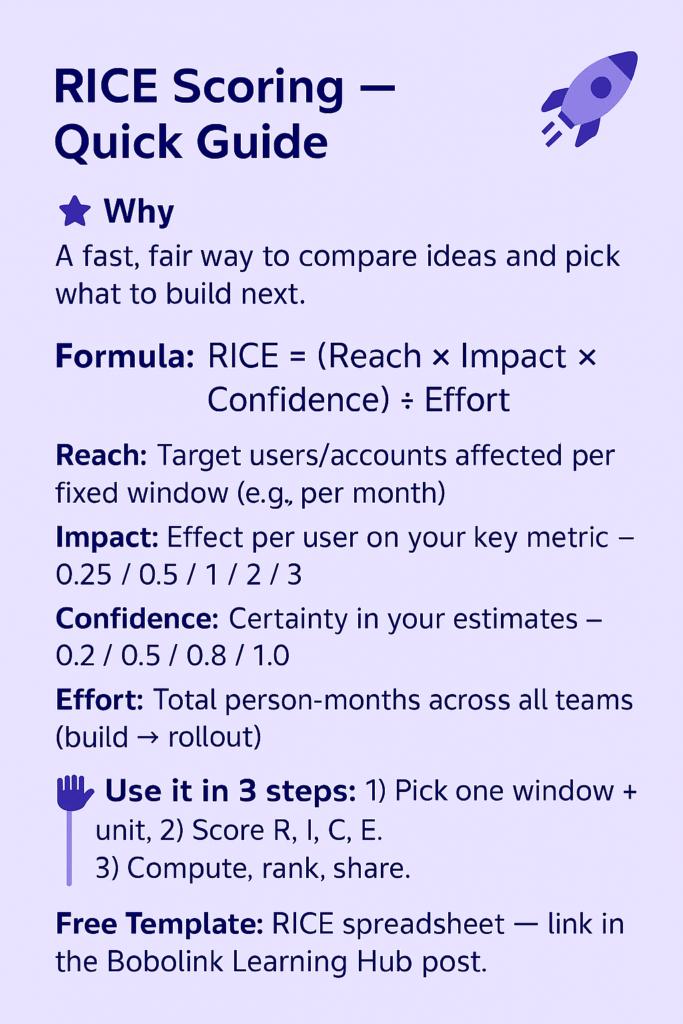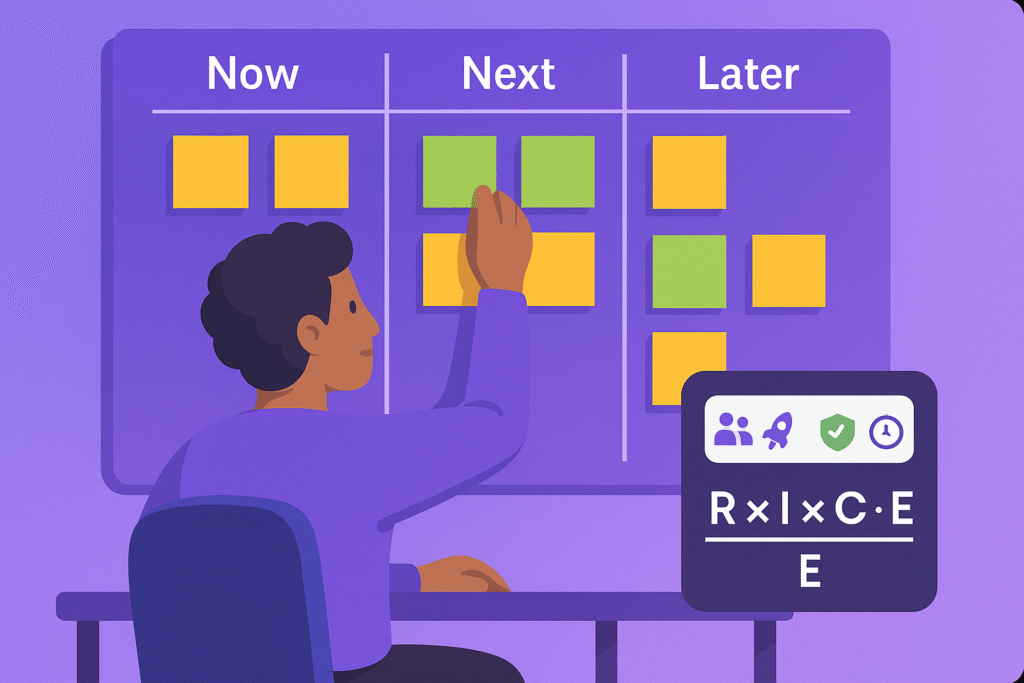Product roadmap prioritization with RICE scoring helps you rank competing initiatives objectively. This guide explains the method, gives a worked example, and includes a free template
What RICE Means for Product Roadmap Prioritization (quick refresher)
- Reach – How many users will be affected in a time window?
- Impact – How much it moves a key metric per user? (3 = massive, 2 = high, 1 = medium, 0.5 = low, 0.25 = minimal)
- Confidence – How sure are you about Reach/Impact/Effort? (100%, 80%, 50%, 20%)
- Effort – Total engineering/design/QA time for the whole project (in person-months or story-points)
RICE score = (Reach × Impact × Confidence) ÷ Effort
Product roadmap Prioritization with RICE: 5 steps
Define the time window
Pick one consistent period for Reach (e.g., 90 days) so projects are comparable.
Collect inputs for each candidate item
Source: analytics (usage, conversion, retention), support volume, sales pipeline, user research, OKRs.
Estimate R, I, C, E
- Reach from data: DAU/MAU segments, # accounts affected, page views, ticket counts.
- Impact mapped to your primary outcome (e.g., activation rate, expansion ARR, retention).
- Confidence tied to evidence quality (experiment/runbook > strong data > directional signal > gut).
- Effort estimated with engineering + design leads (T-shirt sizes → convert to person-months).
Score and sort
Compute RICE for each item; sort from highest to lowest. Cluster similar items (e.g., onboarding) to spot themes.
Pressure-test the top 5
Sanity-check against strategy & constraints: company bets, compliance, platform parity, partner contracts. Adjust only with written rationale.
Product Roadmap Prioritization Example
Context: B2B SaaS with 5,000 WAUs, aiming to improve activation and reduce time-to-value.
| Candidate | Reach (90d) | Impact | Confidence | Effort (pm) | RICE |
|---|---|---|---|---|---|
| In-app onboarding checklist | 3,000 | 2.0 | 0.8 | 3 | 1,600 |
| Usage-based pricing pilot | 400 | 3.0 | 0.5 | 4 | 150 |
| Dark mode | 1,200 | 0.5 | 0.9 | 2 | 270 |
| CSV import reliability fix | 1,800 | 1.0 | 0.9 | 1 | 1,620 |
Decision: Ship CSV import reliability and onboarding checklist first (highest RICE, aligned to activation/TTv). Park pricing pilot until data confidence increases.
Common Pitfalls (and fixes)
Inflated impact → Anchor to a single metric and a public scale (3/2/1/0.5/0.25) used by the whole team.
Effort optimism → Use ranges (pess/likely/optimistic) and average; revisit post-spike.
Reach hand-waving → Pull a real segment count (events/users/accounts) for the chosen window.
Scores drift → Re-score monthly or at each planning cycle with the latest data.
Template (paste into Sheets/Excel/Notion)
Columns: Initiative | Problem/Outcome | Reach (period) | Impact (scale) | Confidence (%) | Effort (pm) | RICE | Notes/Dependencies | Decision
Formula: =(Reach*Impact*Confidence)/Effort
Confidence as decimals (e.g., 80% → 0.8). Freeze top row; add conditional formatting on RICE.
Try It Now (10-minute sprint)
List 8–12 backlog candidates tied to your current OKRs.
Fill RICE quickly with your team leads.
Sort by RICE; choose the top 3 to spec this week.
Post the sheet in your #product channel. Invite challenges for 24 hours, then lock.
Pro Tips
Pair RICE with North-Star metrics and guardrails (e.g., don’t reduce activation at the cost of NPS).
Add a “confidence notes” column linking evidence (dashboard, user interview, experiment doc).
After shipping, retro: compare predicted vs. actual impact; adjust your impact scale calibration.
FAQs
Q: What if we’re pre-data?
A: Use proxy reach (e.g., # of accounts in pipeline) and set Confidence = 0.5 until you validate with a quick test.
Q: How do we handle tiny but mandatory items?
A: Tag them as Run-the-Business (RTB) and schedule separately so they don’t crowd strategy work.
Q: When should I use product roadmap prioritization (RICE) instead of a simple ICE score?
A: Choose RICE when you need precision, transparency, and defensible trade-offs for bigger bets. RICE forces you to estimate Reach, Impact, Confidence, and Effort, which makes it better for quarterly planning, cross-team work, and initiatives where audience size and delivery cost vary a lot.
Cross-read
Time Management Strategies for Busy Professionals – tactical day planning for PMs. – https://bobolink.ai/time-management-strategies/
Critical Thinking & Problem-Solving at Work – sharpen trade-off decisions. – https://bobolink.ai/critical-thinking-problem-solving-work/
Further Reading
For an in depth dive take a look at https://www.intercom.com/blog/rice-simple-prioritization-for-product-managers/ for more.


